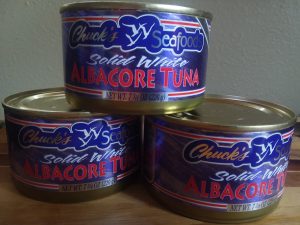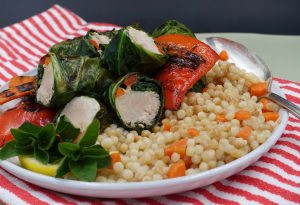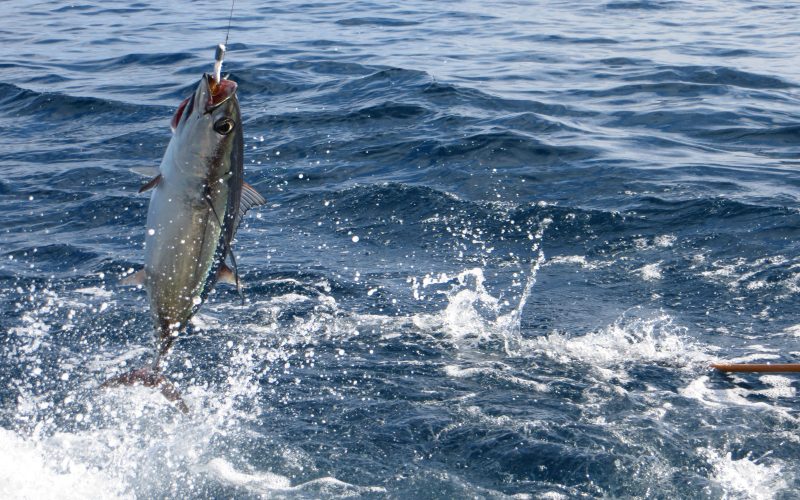STORY BY JENNIFER BURNS BRIGHT
In a modern version of an ancient Roman recipe, albacore tuna grills up moist and pretty in healthy summer wraps.
James Beard famously proclaimed it tasted better canned than fresh. Shaped like a silvery, shimmery bullet, albacore tuna has been fished commercially on the West Coast for over a century, and it’s sold from boats along the Oregon coast in its short season from mid-July through September. Generations of Oregonians grew up eating it from the tin, flaked and mixed with mayonnaise for a school lunch or baked in casseroles.

So does it taste better from the can? One of the earliest canneries in California, Van Camp Seafood, dubbed its canned albacore “Chicken of the Sea” because of its mild taste and consumer appeal, and it’s still one of the most popular fish sold in the country.
But the albacore is more athlete of the sea than fowl, its body streamlined and pectoral fins long enough to knife through the water. Its circulatory system regulates body temperature and metabolism to conserve energy on long journeys. A highly migratory species, North Pacific albacore swim across to our waters from Japan each year in large schools that munch on small oily fish like anchovies and herring. They travel at speeds that sometimes exceed 50 miles an hour, often with dolphins. And with fish as with people, sometimes you hang out with the wrong friends. Prior to the 1970s, commercial fishermen would use dolphins to locate and trap albacore with large purse seine nets that they would encircle around their dolphin companions, often hurting or killing the dolphins in the process.
This led to the U.S. Marine Mammal Protection Act of 1972, and a successful campaign for “dolphin-safe” labeling that ensured international canneries, too, altered their practices.
Still, the demand for canned tuna far outweighed that of fresh—until the rise in popularity of sushi in the US in the past couple of decades coincided with the ability of local fishermen to access schooling tuna more easily due to boat technology and schooling habits that are closer inland than before. Bluefin tuna, popular as the maguro in sashimi and spicy tuna rolls, became more threatened as demand rose, and albacore began to appear as an affordable and sustainable option on menus in the Pacific Northwest. It is often quickly seared on top with a torch and brushed with a citrusy soy dressing.
Grilled albacore, too, appears in restaurants as medallions, lightly browned on the outside with a mostly pink and rare interior.
Offering albacore as either pressure-cooked tuna in a can as one option and raw or rare tuna as the other leads us to albacore’s fatal flaw: it is difficult to cook it until moist and flaky like other Pacific Northwest fish because it has a terrible tendency to seize up and dry out when cooked through, resembling less something from the sea and more like chalk. The brownish-pink flesh turns grey and unappealing. And even quickly seared on the grill, albacore can develop a tough, stringy exterior when not done right. As someone who seems to cook albacore constantly all summer, since I usually have leftover loins from canning my own tuna, I’ve had plenty of time to experiment with recipes for my seafood culinary classes and summer parties.
 I thought I’d develop a recipe that would allow the fish to be moist when served warm with grilled vegetables and a grain like Israeli couscous, and still taste good cold as a luncheon dish sliced and served with homemade mayonnaise or a tonnato sauce (where canned tuna is blended with a little anchovy, lemon, and mayo). The only essential was that it needed to be cooked through but still fresh, great for pleasing more squeamish eaters at the table and for serving leftovers.
I thought I’d develop a recipe that would allow the fish to be moist when served warm with grilled vegetables and a grain like Israeli couscous, and still taste good cold as a luncheon dish sliced and served with homemade mayonnaise or a tonnato sauce (where canned tuna is blended with a little anchovy, lemon, and mayo). The only essential was that it needed to be cooked through but still fresh, great for pleasing more squeamish eaters at the table and for serving leftovers.
The secret to this holy grail of albacore recipes? Swiss chard! Food truly lovely for those with access to a fig tree, I developed a more universal recipe that substitutes blanched Swiss chard. You can also use foraged grape leaves or collard greens for a thicker but still delicious wrap. I also add more olive oil, lemon, and a little honey for a surprising sweet softness.
By marinating both the albacore and the leaves in lemony wine and olive oil, perfumed by oregano, then rolling raw fish into little dolma-like cylinders, you keep the moisture and flavor in the fish. Be sure to use plenty of salt in the marinade. The dish provides a pretty alternative to grilled salmon, or addition if you serve as an appetizer. Plus, you get your vegetables in every bite, especially if you tuck strips of roasted red pepper and carrots into each parcel before you roll it up.
JUICY GRILLED ALBACORE WITH VEGETABLES WRAPPED IN CHARD
Serves 2
This recipe is remarkably versatile. It can be grilled, as I describe here, or baked in the oven 10–12 minutes at 400 degrees until the flesh inside loses its pink hue and is solid white.
Ingredients:
One medium-sized albacore loin, cut into 1 to 1.5-inch
medallions. Save the trimmings for use as the last wrap.
3 tablespoons olive oil
1 lemon, half juiced and the other half sliced thinly
1 tablespoon minced fresh oregano
2 teaspoons salt, divided in half
5–6 large chard leaves, with the ribs shaved down so
leaves are flexible
1/2 cup dry, acidic white wine with good structure
1 tablespoon honey
A few julienned red pepper and/or carrot strips
1. Marinate the sliced albacore in 2 tablespoons of olive oil, the juice of half a lemon, the oregano, and a teaspoon of salt in a gallon-sized Ziploc bag. Let sit 20 minutes on the counter.
2. Bring a pot of water to boil, and prepare an ice water bath. Dip the chard leaves into the hot water to soften, then immediately plunge them into the ice water. Squeeze out water, then spread open the leaves and macerate them in the wine, salt, and the rest of the olive oil.
3. Roll your wraps. With the heavier base of a chard leaf close to you, add a piece of tuna and some oregano atop the leaf, then add a few strips of pepper/carrot and a small dollop of honey (trust me). Fold over the bottom, then the sides inward, and then roll the rest of the package. Set it on a tray seam-side down. Repeat until finished. You should then pour the rest of the liquid on the packets.
4. Grill on a skillet or directly on the grate, taking care to make sure the latter is oiled well. Cooking happens quickly, perhaps 10 minutes. (Or see instructions for oven roasting, above.) Don’t overcook. For either method, the fish should feel less like touching the soft part of your cheek and more like the feel of the tip of your nose. Check one roll. If it still seems a bit too rare inside, cover the pan and let it sit for a few more minutes on the counter before serving warm with an interesting grain and roasted vegetables, or chill to slice thinly the next day for a luncheon. A mayonnaise-based sauce is optional.
This story was published in the Summer 2019 issue of Oregon Coast magazine.




